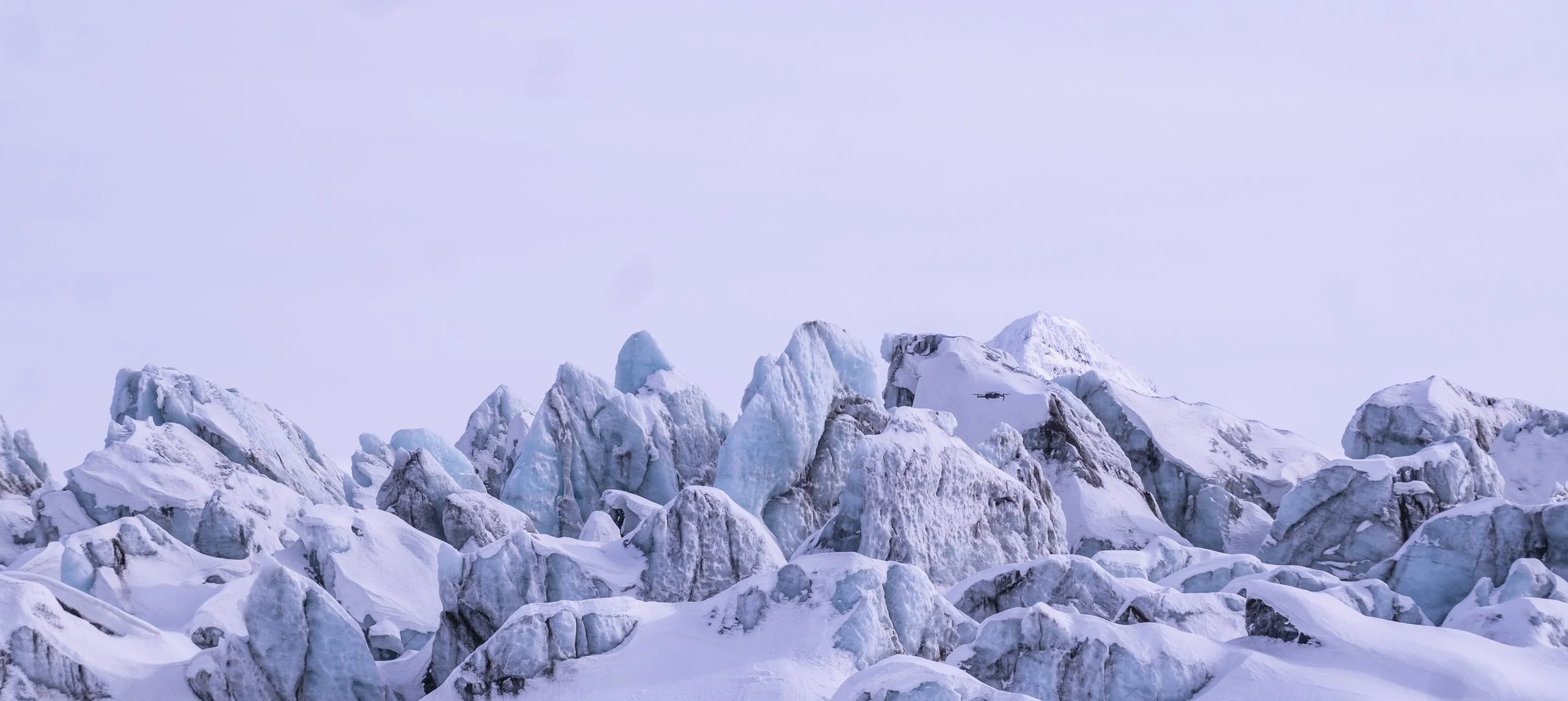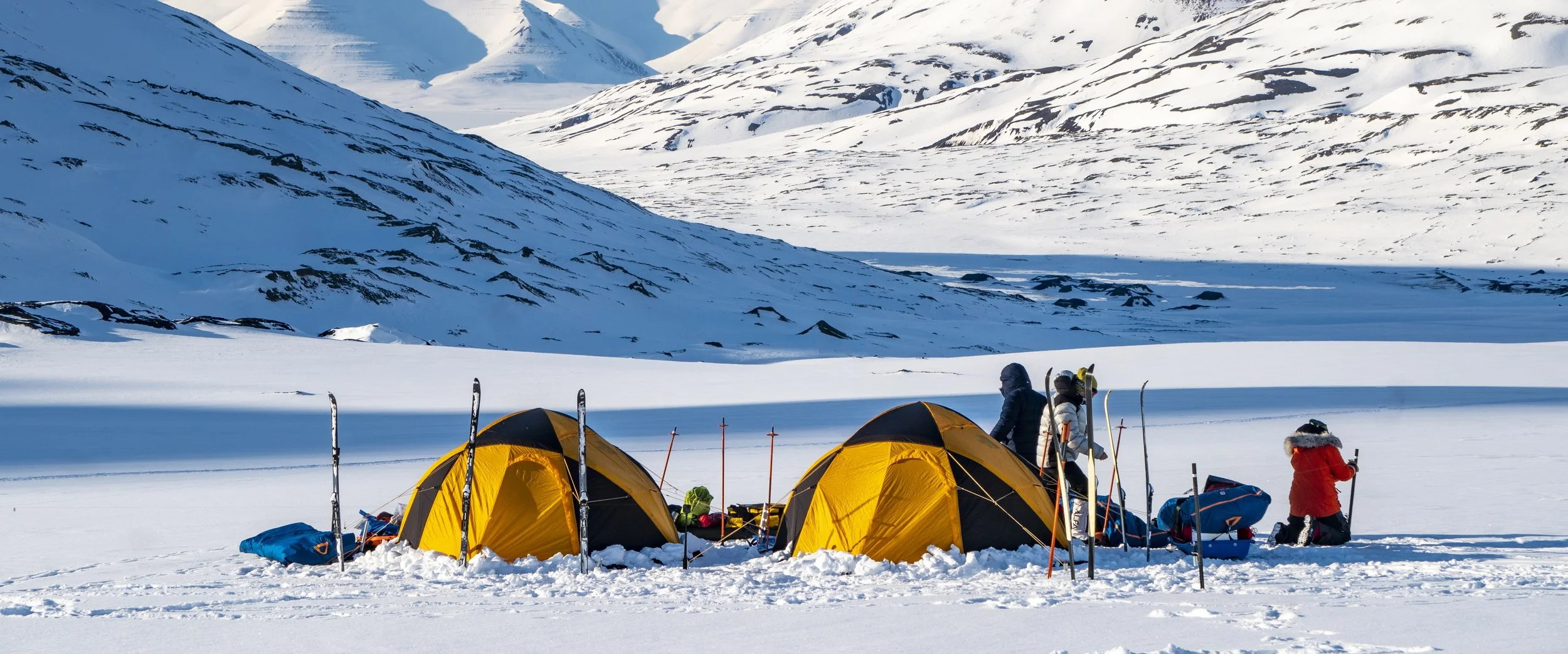Glacial Light
Why albedo is crucial in Earth’s attempt to keep cool
Story by Seddie LeBlanc
Photos courtesy of Heïdi Sevestre
Four sentinels on skis posing triumphantly in front of a bright blue glacier. The archipelago of Svalbard is covered at 60% by glaciers.
When you approach a glacier, oftentimes you feel it before you see it. The wind picks up and stings against any exposed skin. The temperature of the air around you drops dramatically. You hear the ice cracking and groaning as it moves across the landscape, propelled by its incredible mass. The glacier will make itself known to you, even before you witness the strata of blue ice webbed through its surface.
Glaciers serve the essential function of reflecting light from the sun back into the atmosphere, instead of absorbing it as a darker surface like the ocean might. The amount of sunlight reflected by a surface is called its albedo. Reflective, high albedo surfaces like glaciers help keep the planet cool.
Glaciers are formed by layers of compacted snow, which have been tamped down and solidified over time. These layers are formed year after year over millennia as air is forced out and snow recrystallizes into ice.
Most glacial mass on Earth exists in ice sheets, a kind of glacier that forms broad domes and spreads out in all directions. Ice sheets are mainly concentrated in the Arctic and Antarctica. Mountain glaciers, however, exist across the globe, from the tropics to our very own Mount Baker.
Our drinking water comes from one of two places in Bellingham: rainwater stored in the Lake Whatcom watershed, or melt from the Deming Glacier on Mount Baker, which flows to the Middle Fork of the Nooksack River and is seasonally diverted into Lake Whatcom through a tunnel under Bowman Mountain. Nearly 2 billion people live in areas where glaciers and seasonal snowmelt supply their drinking water. Loss of glacial ice reduces the amount of fresh water available for plants, people and animals across the globe. If all of the world’s glaciers were to melt, the sea level would rise by 216 feet, according to National Geographic — that’s enough to put most of Bellingham underwater. The shoreline could begin at Garden Street and turn Western Washington University into an island.
In 2022, the U.N. declared 2025 the International Year of Glaciers Preservation, with March 21 as the World Day for Glaciers. Heïdi Sevestre, a French glaciologist, science communicator and deputy secretary at the Arctic Monitoring Assessment Program, studies glaciers across the globe. She says the feeling she gets when encountering a glacier is almost magnetic — ever since she was young, growing up in the French Alps, she felt called to them.
“I instantly fell in love with it because it felt like the ice was alive, the noise it would make just walking on it with the crampons, the cool temperatures. It felt really powerful. It felt absolutely massive,” Sevestre said.
In 2021, Sevestre led an all-female expedition in Svalbard, a Norwegian archipelago in the Arctic. She built a research program with Western Washington University professor Alia Khan studying black carbon deposition and albedo.
“The Arctic is basically this giant white blanket,” Sevestre said. “Every time we have air pollution or forest fires, we can have black carbon landing on snow and ice. Obviously it makes these surfaces darker and really catalyzes the melting of this part of the cryosphere.”
Darker surfaces absorb more heat, like how wearing a black tee on a sunny day will make you overheat and a white tee will keep you cool.
Changes in the Arctic are linked to a phenomenon Sevestre referred to as “climate weirding,” where weather trends oscillate more wildly and patterns of weather events become more extreme over time.
The Arctic is warming faster than the rest of the Earth — roughly two to four times faster, according to Judah Cohen, a climatologist and director of seasonal forecasting at Atmospheric and Environmental Research and Research Affiliate at MIT.
“Intuitively, you would think that those changes would lead to warmer winters at lower latitudes since the Arctic is the source of cold air in the winter months,” Cohen said. “But I and some others have tried to argue that the change in the Arctic can lead to this increase in episodes of more severe winter weather, so extreme cold, disruptive snow storms.”
Mountains cast in a purple hue from the Climate Sentinels expedition in Svalbard in April 2021.
Much of Cohen’s research is focused on the polar vortex, an area of low pressure that sits over the North Pole in the stratosphere and influences the movement of cold air. When the polar vortex is strong, cold air is contained closer to the Arctic. When the vortex is weaker, cold air moves south. Cohen refers to the weakening of the polar vortex as a kind of stretching: when the vortex is strong, it is contained close to the North Pole. As it weakens and stretches, it becomes more oblong. These stretching events are happening more frequently, and Arctic ice loss could be contributing to this increased frequency, according to Cohen.Rising sea levels and unpredictable weather events are just two effects of melting glaciers. But the loss of high-albedo glaciers also directly increases the absorption of solar energy. When ice melts, it is replaced by a low-albedo ocean surface, creating a vicious cycle of rising temperatures.
For the more than 40 Indigenous populations in the Arctic, the loss of ice can lead to the loss of traditional ways of life.
Tara Corpuz is a government agency and engagement coordinator with the United States National Science Foundation Center for Braiding Indigenous Knowledges and Science (NSF CBIKS) and a research intern with The Arctic Institute.
Her work centers on facilitating meaningful conversations between Indigenous communities and Western scientists. She says that including Indigenous people at every step of the research process is key to good climate science. Corpuz encourages non-Indigenous people to think about their connections to family and upbringing when facilitating conversations and building relationships with Native people in the workplace. She spent her summers growing up in the Arctic Village, Alaska, a remote Gwich’in community where her family has lived since time immemorial. She said that, as an Alaska Native person, she was raised with a different way of seeing the world. Growing up, she spent most of her time in Anchorage.
Skis staked into the ground around the Climate Sentinels campsite during their expedition in Svalbard in April 2021.
“For years, I often went back and forth between these two worlds, pursued an education, chased a career, and have taken it upon myself to communicate what I know with others who didn’t have the privilege of growing up like I did. That’s mine, and I can share it,” Corpuz explained in a follow-up email. Home to some, the Arctic is also full of natural resources, which are desired by the fossil fuel industry because they are immensely profitable.
This framing of the natural world as monetarily valuable is part of the problem. Indigenous people have been living holistically in the Arctic since time immemorial and fighting to protect it from those who wish to destroy it for profit. Corpuz said that, as the ice melts, more land beneath it will become accessible to drill and exploit for oil.
Corpuz challenged the idea of picking and choosing which land is fit for conservation and which land should be exploited. She said that isn’t how Native people view the world.
“We are all related. You wouldn’t take your uncle’s eye because ‘the rest of him will be fine’ — and years after you took the eye, you wouldn’t then throw him out back and take his limbs because ‘This is already used, might as well take everything,’” she wrote in the email.
Maiyuraq Lauryn Nanouk Jones is an Iñupiat/Inuit third-year Western student studying Environmental Science and 2023-2024 Arctic Youth Ambassador. She grew up in Unalakleet, Alaska, a remote community of about 700 people in the Sub-Arctic. In high school, Nanouk Jones worked for the Sitka Conservation Society in Sitka, Alaska. Her Arctic East Ambassador connected her with the Arctic Youth Network roughly two years ago. Nanouk Jones said when she came to Western she noticed how few people are aware of how rapidly the Arctic is warming and how Indigenous people in the Arctic are impacted.
“I saw those things growing up. I went crabbing on the sea ice. I grew up going fishing for salmon in the summers, that kind of experience,” Nanouk Jones said. “The way I grew up is very different. That’s not something people think about, like how you’re going to be able to feed your family all year round in a place where milk is like $10.”
She said she has noticed those food sources dwindle over the years. This last year, her family spent over a week going out by boat to catch fish an hour and a half away. They used to be able to access fish on the river close to their home.
She said maintaining hope is difficult in climate work, especially while witnessing the changes in the Arctic, but connecting with other youth advocates has helped.
“When I get to meet with my friends from Canada or Greenland or any Northern country, it’s youth leaders that are doing the work to be able to preserve our way of life and to be able to protect our homes, so it gives me a lot of hope for our future,” Nanouk Jones said.
While Arctic communities will experience some of the first and most devastating effects of glacial ice melt, everyone on Earth is feeling the effects of climate change, and it’s only getting worse. Ice loss in the Arctic means our planet as a whole has a lower albedo and is less resilient to rising temperatures and the effects of greenhouse gas emissions.
“For us in the Arctic, albedo is a very serious topic, because we know that the Arctic is overall getting darker from the loss of land ice and sea ice,” Sevestre said. “The fact that the albedo of the Arctic is changing is affecting the rest of the world.”
One suggestion for people who want to make an impact? Learn about Indigenous people where you live and in the Arctic, Nanouk Jones said.
“A lot of people care about whether glaciers are receding or the ice melting or even polar bears dying. But who is that impacting, also? We Inuit people have to rely on polar bears to survive, and so that’s how sea ice loss is impacting us, not just because we see it happening, but it’s impacting our way of life,” she said.
Mountains cast in a purple hue from the Climate Sentinels expedition in Svalbard in April 2021.




